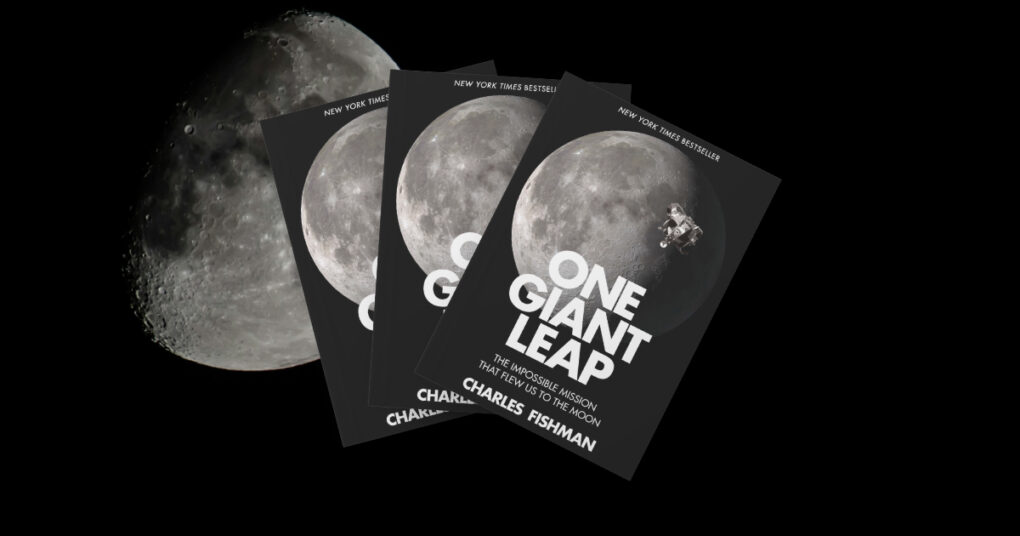One Giant Leap: The Impossible Mission that Flew Us to the Moon
Charles Fishman
Simon and Schuster
2019
488 pages
ISBN: 978-501106293
This book does far more than tell the story from so many different perspectives of the Apollo mission that famously landed on the moon in July 1969 when Neil Armstrong uttered those iconic words: “One small step for a man, one giant leap for mankind.” It sets the scene in the global political context of the Cold War and the Space Race between the USA and the Soviet Union, indeed in many ways it is a history of that relationship and the whole decade of the 1960s, one that has many resonances for today.
In October 1957, little more than a dozen years after Europe, East and West emerged from World War II ravaged and in need of huge rebuilding, the Soviets shocked the world by launching the world’s first artificial Earth satellite, Sputnik 1. The Americans were reeling from the shock but, from their point of view, worse was to come. Over the next few years, the Soviets scored several more “firsts”: the first animal in space, the first man in space – Yuri Gagarin – in April 1961 and the first woman in space – Valentina Tereshkova – in 1963. Apart from the hurt to national pride, the fear for national security felt by the government of the United States led to a total reappraisal of their fledgling space programme. In May 1961, just days after Alan Shepard became the first American to leave the earth in a short flight of barely fifteen minutes’ duration (which unlike Gagarin didn’t even orbit the earth), newly elected President John F. Kennedy in a speech at Rice University demanded of NASA that they put a man on the moon by 1970.
Objectively speaking the demand was crazy, given the state of the USA’s space programme, and of technology at the time. From today’s perspective when our mobile phones contain far more sophistication than the computers that took Apollo 11 to the moon and back, the fact that NASA delivered on Kennedy’s demand is all the more extraordinary. The book goes into great detail on the steps in the Apollo missions, including the setbacks, most notably the tragic loss of life of three astronauts who died in a flash fire aboard their spacecraft during a ground test on the launch pad of Apollo 1 in January 1967. Extraordinary progress was made through the 1960s as one after another the Apollo missions broke new ground. Particularly spectacular, (extraordinary to those of us who remember it happening) was the message to the world from the far side of the moon from the men of the Apollo 8 mission. It began with the opening words of the Book of Genesis, perhaps as a counter-point to the comment ascribed to Yuri Gagarin about there being no God visible from space.
Among the developments, the brightest and the best scientists from NASA and MIT collaborated (and sometimes argued) as they progressed into the great unknown. Issues that had to be resolved included the building of a rocket powerful enough to send them on the journey, the design of the Lunar Module, how to synchronise its release from the Apollo Craft and of course how to ensure its return to the mother ship and return to earth, as well as many problems, mathematical and otherwise. Fishman has done a mighty job of research with over eighty pages of footnotes, though it’s by no means necessary to delve into all of these to relish the thrilling adventure on so many fronts that the Apollo programme was.
And there were dissenting voices. Many were concerned at the huge cost of the mission at a time when many Americans lived in dire poverty. Even Kennedy himself harboured certain doubts about what he had bluntly ordered NASA to achieve, though it must be said that after his death, President Johnson put his full weight behind the programme. We can definitely say that the Apollo mission advanced development of computer technology and we can certainly thank those at the frontier in the 1960s for the luxuries we take for granted today.
Though it deals with complex mathematical and engineering issues this is an eminently readable book and I can thoroughly recommend it. As well as describing the developments in the programme and the people involved (geniuses many of them), it paints a picture of a more united America (despite the divisions caused by the Vietnam War) than that which, unfortunately, we see today. It is also a testament to what great minds working together can achieve in a positive sense, as distinct from the growth in the arms industry which promises only death and destruction.
About the Author: Pat Hanratty
Pat Hanratty taught Science/Chemistry in Tallaght Community School from its inception in 1972 until he retired in 2010. He was the school’s first Transition Year Co-ordinator and for four years he had the role of Home School Community Liaison Officer.

